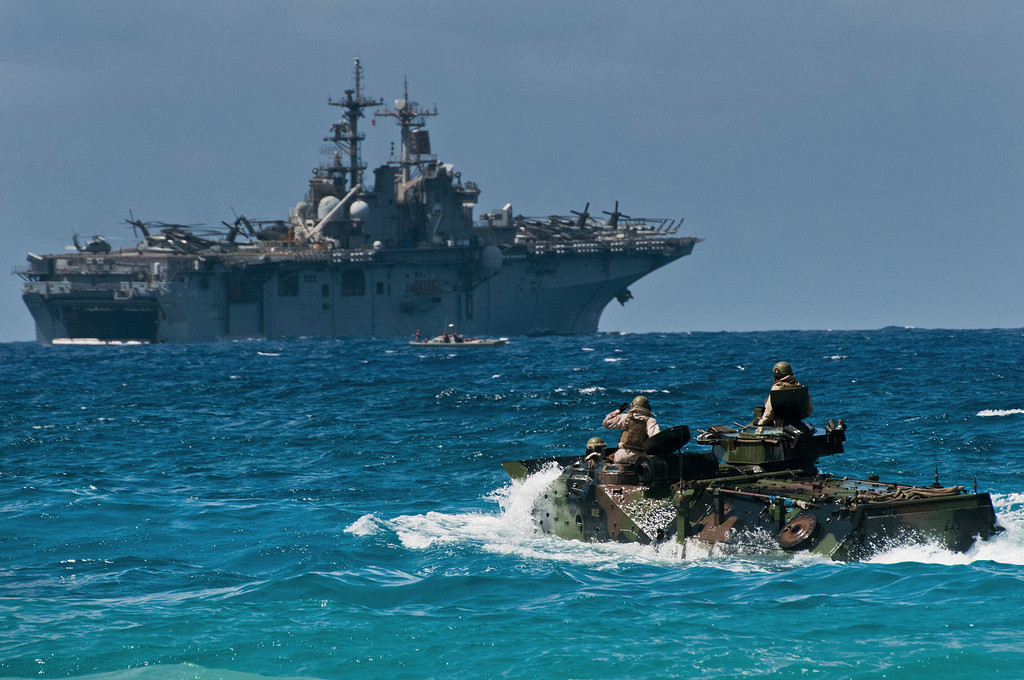No, the Amphibious Assault Isn’t Dead

Last weekend, Zachary Keck at The Diplomat joined a long and illustrious line of commentators predicting the death of the amphibious assault. The idea becomes fashionable every couple of wars. Horatio Nelson was the trendsetter with his quip, “A ship’s a fool to fight a fort.” The concept became especially popular after the failure of the Gallipoli campaign in 1915. D-Day and the other brutal assaults of World War II precipitated another round of criticism and prompted General Omar Bradley, Chairman of the Joint Chiefs of Staff from 1949-1953, to comment that, “Large-scale amphibious operations such as those that occurred at Sicily and Normandy will never occur again.” He said this less than a year before Douglas MacArthur launched his amphibious assault on Inchon.
While these predictions have all been wrong, they did identify dynamics present in the tactical environment of their respective ages that made projecting force from sea to shore more difficult. Coastal artillery in the late 19th Century and the machinegun in the early 20th Century were challenges that needed to be overcome. But overcome they were. The strength of forts was negated by new tactics made possible by steam power, such as the elliptical pattern employed by Union Captain (USN) Samuel Du Pont against Confederate Forts Walker and Beauregard at Port Royal Sound in 1861. The Gallipoli campaign failed less because of the machinegun and modern artillery and more because of a slapdash logistical plan and the use of troops unfamiliar with the exigencies of amphibious operations. After the defeat at Gallipoli, the U.S. Marine Corps began a serious analysis of amphibious assault tactics. The doctrine and procedures produced by that analysis were used for nearly every Allied assault during World War II from Anzio to Okinawa.
Today’s threat is the precision-guided missile. Whether directed at amphibious ships themselves or the ship-to-shore connector – such as the Amphibious Assault Vehicle – these missiles present a significant hurdle to the landing force. Land-based missiles push amphibious shipping further offshore, forcing the connectors to cover a greater distance and thus increasing their exposure to enemy fire. The best solution is to land where the enemy is not prepared to contest the landing, but that is not always possible. Even on D-Day some beaches were deserted and others bristling with German defensive positions. This is especially true in the Pacific where small islands can be defended at every avenue of approach.
But the tactical dynamics have changed drastically since 1944, making precision-guided missiles less of a threat than breathless declarations of game-changing technology purport. Precision-guided munitions are a double-edged sword: missile emplacements ashore are vulnerable to precision-guided missiles launched from ship or from aircraft. Another technology that was not present in 1944 is the helicopter. The landing force does not solely use surface connectors but rather combines surface with air assault, allowing troops to tackle missile emplacements ashore. One other avenue of approach is subsurface: submarines make SEALs another threat to the shore defense. And of course, a critical component of the successful D-Day landing was the airborne component that dropped troops behind the lines, a tactic that was effective for both Imperial Japanese and German assaults early in the war. An airborne component could again be a critical U.S. Army contribution to a particularly intractable future amphibious assault.
Moreover, precision-guided missiles have been present above and on the battlefield for decades. Yet their presence did not end aerial combat. In theaters where there is a significant anti-air missile threat, a SEAD/DEAD (Suppression of Enemy Air Defense/Destruction of Enemy Air Defense) campaign is used to mitigate the threat enough to allow friendly aerial operations. So too could the methods described above be combined into a Destruction of Enemy Missile Offense (DEMO)* campaign that mitigates the threat of precision-guided missiles ashore enough to allow the landing force to hit the beach. There is an array of assets within the U.S. inventory that can be used to mitigate the threat of shore-based missiles.
Precision-guided missiles present an old but not insurmountable challenge for forcible entry. Not only are precision-guided munitions not particularly new, but the dynamic of advanced weaponry – be it breech-loaded cannons, machineguns, or missiles – driving amphibious shipping farther offshore is old as well. Just as old is the pattern of tactical evolutionary responses designed to negate the defensive advantage of shore-based weaponry. As for likelihood, one only has to look at the South China Sea to be reminded of the importance of amphibious power. The struggle for control of the western Pacific has already begun. Should that political struggle take on a violent character, islands in the western Pacific will need to be taken, held, or retaken. This will inevitably be bloody business and precision-guided missiles certainly make the job that much harder. But amphibious assaults are not yet impossible and are unfortunately all too likely.
*Not a real acronym. I made it up.
Captain Brett Friedman, USMC is a field artillery officer stationed at Camp Lejeune, NC. He normally writes for the Marine Corps Gazette blog. His views do not represent the USMC.
Photo credit: Official U.S. Navy Imagery

